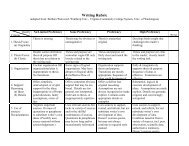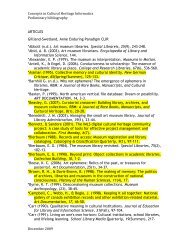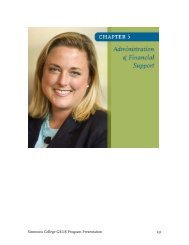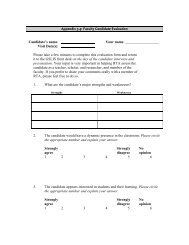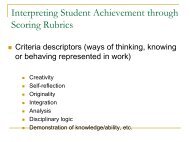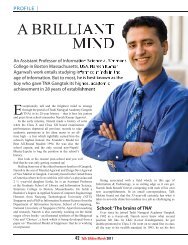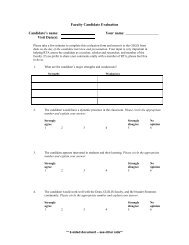SIGCHI Conference Paper Format - Graduate School of Library and ...
SIGCHI Conference Paper Format - Graduate School of Library and ...
SIGCHI Conference Paper Format - Graduate School of Library and ...
Create successful ePaper yourself
Turn your PDF publications into a flip-book with our unique Google optimized e-Paper software.
esearch? 2) Of the titles that include research, what<br />
percentage <strong>of</strong> the articles in each title are research<br />
articles? 3) What is the subject distribution in both the<br />
research articles <strong>and</strong> non-research articles? 4) What<br />
methodologies are used in the research?” LIS periodicals,<br />
available both in print <strong>and</strong> online, will be collected,<br />
analyzed, <strong>and</strong> categorized. Article abstracts will be used to<br />
determine the subject <strong>and</strong> methodology <strong>of</strong> research articles.<br />
The LIS databases <strong>and</strong> periodicals stacks will be used to<br />
determine a sample size collection for this study.<br />
The findings <strong>of</strong> this study could potentially impact how LIS<br />
Librarians support LIS researchers. A better underst<strong>and</strong>ing<br />
<strong>of</strong> the percentage <strong>of</strong> available literature that is research, as<br />
opposed to non-research, could potentially lead to an<br />
improved search experience. This study will also provide a<br />
snapshot <strong>of</strong> the topics covered <strong>and</strong> methodologies used in<br />
research in 2011. Librarians <strong>and</strong> established researchers<br />
mentoring new researchers would have a more concrete<br />
sense <strong>of</strong> the amount <strong>of</strong> literature available.<br />
LITERATURE REVIEW<br />
There have been a number <strong>of</strong> content analysis papers<br />
published regarding LIS periodical <strong>and</strong> journal literature.<br />
These studies have primarily focused on the subjects<br />
covered <strong>and</strong> methodologies used in LIS research (Feehan,<br />
Havener, <strong>and</strong> Kester, 1987; Nour, 1985; Jaervelin <strong>and</strong><br />
Vakkari, 1990; Kumpulainen, 1991). While these studies<br />
provide valuable information regarding the trends <strong>of</strong><br />
research literature, they tend to focus on analyzing articles<br />
from a list <strong>of</strong> core LIS research journals. These studies<br />
intentionally exclude all non-peer reviewed <strong>and</strong> referred<br />
journals (Feehan, Gragg II, Havener <strong>and</strong> Kester, 1987;<br />
Jaervelin <strong>and</strong> Vakkari, 1993; Koufogiannakis <strong>and</strong> Slater,<br />
2004; Kumpulainen, 1991; Nour, 1985). The scope <strong>of</strong><br />
content analyses in these past studies was on a limited list<br />
<strong>of</strong> journals with a research focus. In each case, the list <strong>of</strong><br />
core journals was compiled after analyzing multiple indices<br />
to identify titles that are included in more than one database<br />
or index. Feehan et al. (1987) also solicited feedback from<br />
library pr<strong>of</strong>essionals as to their opinion <strong>of</strong> the core journals<br />
in LIS. All studies explicitly excluded international<br />
journals. Only Jaervelin <strong>and</strong> Vakkari (1990, 1993) included<br />
non-English international journals.<br />
The total list <strong>of</strong> core journals thus varied from as little as 10<br />
journals (Arahony, 2012) to 91 (Feehan et al., 1987). This<br />
indicates that there is no consistency in what qualifies as a<br />
core journal. Another factor briefly addressed by Jaervelin<br />
<strong>and</strong> Vakkari (1993) is the nature <strong>of</strong> the publishing industry.<br />
Core journal lists vary between decades because the core<br />
journals identified for one decade may cease to exist before<br />
another <strong>and</strong> new core journals may emerge since the initial<br />
year <strong>of</strong> cross-decade studies (p. 131). It is therefore<br />
generally difficult to develop an unbiased, consistent list <strong>of</strong><br />
journals that qualify as research-based or pr<strong>of</strong>essional, even<br />
when cross referencing lists <strong>of</strong> indexed titles as a means <strong>of</strong><br />
developing the core list.<br />
While part <strong>of</strong> the fluctuation can be attributed to trends in<br />
the field, it is also due in part to varying methods <strong>of</strong><br />
conducting research (Jarvelin <strong>and</strong> Vakkari, 1990). Related<br />
to this is the fact that even when only analyzing core<br />
journals, not 100% <strong>of</strong> what is published in these research<br />
journals is research (Feehan, Gragg II, Havener <strong>and</strong> Kester,<br />
1987; Buttlar, 1991; Nour, 1985; Jarvelin <strong>and</strong> Vakkari,<br />
1990; Kumpulainen, 1991).<br />
The changing lists <strong>of</strong> journal titles selected for analysis also<br />
resulted in skewed results <strong>of</strong> the percentage <strong>of</strong> research<br />
literature. Jaervelin <strong>and</strong> Vakkari found that as much as<br />
54% <strong>of</strong> their sample qualified as research while Feehan et<br />
al. (1987) found that only 23.6% <strong>of</strong> the sample qualified as<br />
research. This discrepancy makes it difficult to develop a<br />
sense <strong>of</strong> the field. An inconsistency in titles included further<br />
exacerbates the effects <strong>of</strong> a fluctuating publishing industry.<br />
The narrowest <strong>of</strong> the studies focused on a list <strong>of</strong> core<br />
journals <strong>of</strong> less than 20 each. Both Buttlar (1991) <strong>and</strong><br />
Arahony’s (2012) studies produced valuable information<br />
about trends in authorship <strong>of</strong> research in LIS literature.<br />
Buttlar (1991) analyzed author information including<br />
geographic location, sex, occupation, <strong>and</strong> geographic<br />
location. Aharony’s (2012) most recent content analysis<br />
went beyond Buttlar’s study <strong>and</strong> presented statistical<br />
descriptive analysis <strong>of</strong> research article keywords as well.<br />
Yet, the limited list <strong>of</strong> journals analyzed brings about the<br />
question <strong>of</strong> the validity <strong>of</strong> the data.<br />
A consistent theme throughout the studies is the need to<br />
define “research” before undertaking a content analysis.<br />
Several content analyses use a consistent definition <strong>of</strong><br />
research as established by Peritz (1980):<br />
Research is any inquiry which is carried out, at least to<br />
some degree, by a systematic method with the purpose <strong>of</strong><br />
[eliciting] some new facts, concepts or ideas (Feehan et al.,<br />
1987; Nour, 1985; Yontar <strong>and</strong> Yalvac, 2000).<br />
But, as Nour suggests, even a highly accepted definition is<br />
“criticized for its lack <strong>of</strong> rigor” (p. 262). This definition is<br />
<strong>of</strong>ten critiqued as being too broad <strong>and</strong> not specific enough<br />
to the field (Koufogiannakis <strong>and</strong> Slater, 2004). Still, this<br />
definition endures for its inclusion <strong>of</strong> its key concepts,<br />
“method” <strong>and</strong> “purpose,” which allow a researcher to more<br />
easily distinguish research articles from other articles<br />
(Feehan et al., 1987; Nour, 1985; Yontar <strong>and</strong> Yalvac,<br />
2000). Use <strong>of</strong> a consistent definition increases the external<br />
validity <strong>of</strong> the studies, even if their core journal lists vary<br />
drastically.<br />
This definition has also been used in content analyses <strong>of</strong><br />
international, non-English journals, further demonstrating<br />
its endurance <strong>and</strong> relevancy (Kajberg, 1996; Yontar <strong>and</strong><br />
Yalvac, 2000). Moreover, the use <strong>of</strong> the same definition<br />
ensures it will still be applicable to a collection that<br />
includes international, non-English journals, as this study<br />
proposes. These international studies also varied in scope.<br />
Like the American studies, Yontar <strong>and</strong> Yalvac (1996)



